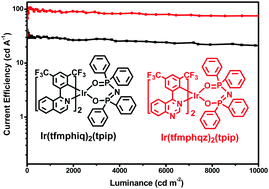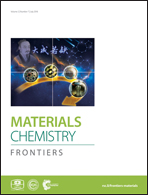Highly efficient yellow electroluminescence of iridium complexes with good electron mobility†
Abstract
Herein, two iridium(III) complexes with yellow emission using 1-(3,5-bis(trifluoromethyl)phenyl)isoquinoline (tfmphiq) and 4-(3,5-bis(trifluoromethyl)phenyl)quinazoline (tfmphqz) as the main ligands and tetraphenylimidodiphosphinate (tpip) as the ancillary ligand were applied in organic light-emitting diodes (OLEDs). The quinazoline moiety greatly influenced the nature of the complexes, and both the quantum yield and the electron mobility of Ir(tfmphqz)2(tpip) were much higher than that of Ir(tfmphiq)2(tpip) (Ir(tfmphiq)2(tpip) (λem: 581 nm and Φ: 0.61) and Ir(tfmphqz)2(tpip) (λem: 566 nm and Φ: 0.97)). Moreover, the device based on Ir(tfmphqz)2(tpip) displayed far better performance than that based on the Ir(tfmphiq)2(tpip) emitter. The device with a structure of ITO/MoO3 (3 nm)/TAPC (50 nm)/Ir(tfmphqz)2(tpip) (6 wt%): 26DCzPPy (10 nm)/TmPyPB (50 nm)/LiF (1 nm)/Al (100 nm) displayed a maximum luminance of 96 377 cd m−2 and a maximum current efficiency and a maximum power efficiency of 106.66 cd A−1 and 64.72 lm W−1, respectively, with low efficiency roll-off. The current efficiency still remains as high as 89.91 cd A−1 at the brightness of 1000 cd m−2 and 79.73 cd A−1 at the brightness of 5000 cd m−2. These results suggest that the Ir(III) complexes with quinazoline units are potential yellow phosphorescent materials for OLEDs.



 Please wait while we load your content...
Please wait while we load your content...